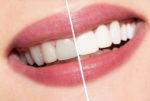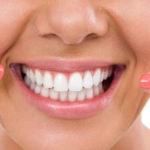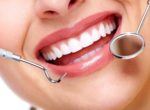Table of Contents
What color are the human teeth? Most people would answer to that question promptly: White. Although this is the correct answer, it is often dependent on the subjective impression of the observer because teeth may be yellow, gray, blue, green, brown, black, red and even pink. We will discuss here all the possible reasons that can cause teeth stains to develop.
Teeth Stains and Discolorations
In its most general terms, any change in tooth color is different from the usual white color can be called staining or discoloration of the teeth. The color change can only partially or completely affect the tooth or the crown. The change of color may be permanent or temporary.
It can be caused from the outside, inside or by the interaction of external and internal factors. Therefore, we say that the causes of the teeth stains is divided into extrinsic (external), intrinsic (internal) and internalized causes. Color changes can affect the isolated individual tooth, but may include more teeth. Tooth color can be changed more during germination, and may change during the life.
Different teeth stains are described differently depending of the cause. However, for the patient the easiest way to describe the teeth stains is by self observation. This is why in this article we will describe teeth stains in such a way that will enable anyone to diagnose discoloration of their teeth. It should help you to narrow down the possible cause of teeth discoloration you may have.
Teeth stains are caused by consumption of the various types of drinks and food. Those stains are most often only temporary. Unless you had drank and eaten those kinds of food and drinks in large amounts and over a prolonged period of time. Here, we will focus only on the other types of teeth discoloration.
[divider style=’centered’]White Teeth
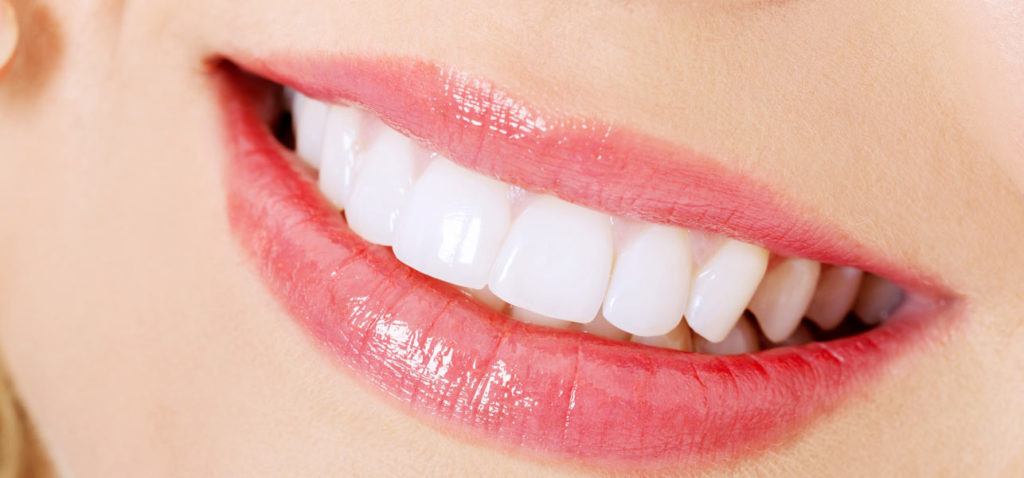 Anatomical crown of the tooth crown was built from two hard dental tissues: enamel and dentin. The enamel is located on the surface of the crown of intact and healthy teeth covering the underlying dentin.
Anatomical crown of the tooth crown was built from two hard dental tissues: enamel and dentin. The enamel is located on the surface of the crown of intact and healthy teeth covering the underlying dentin.
The enamel is usually gray or bluish-white, but is also translucent. Because of this property to let through the rays of light, the color of teeth depends not only on the color of the enamel but also the color of dentin beneath the enamel, which is pale yellow in color. This is most evident in the areas where the enamel is thin.
The white color is the default and normal color of intact and healthy teeth. Although permanent teeth are white, Their shades may vary from bluish-white to yellow-white. Milk teeth are usually lighter in color than permanent. Their color is white with a bluish outflow and chalky sheen.
On the teeth of the normal color it is possible to find larger or smaller areas of different shapes (dashes, dots, etc.) that are opaque white. Those are the hypomineralized areas of tooth enamel which are formed due to a smaller amount of minerals in those areas. They break the beams of light differently compared to normal enamel, which is up to 98 percent made up of inorganic substances.
Given the fact that these areas are white and have a chalky glow, creates a stark contrast with the surrounding parts of the teeth thus they usually appear darker than they are.
The causes hypomineralization may be different. Some are appearing during tooth development, and some after. Dental fluorosis which occurs due to excessive amounts of fluoride in water and food during the embryonic development of dental hard tissues may present the appearance of just such a whitish discoloration that are usually visible on the labial surfaces of the upper incisors.
[divider style=’centered’]Yellow Teeth
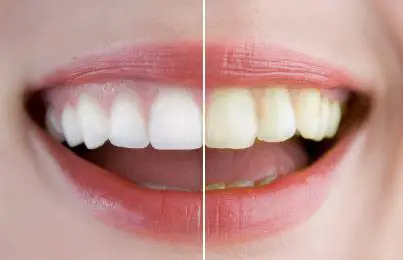 Teeth take on a yellow color when tooth enamel becomes very thin or is totally worn up. The dentin, which is located under the enamel has a pale yellow color that shines through the semi-transparent enamel.
Teeth take on a yellow color when tooth enamel becomes very thin or is totally worn up. The dentin, which is located under the enamel has a pale yellow color that shines through the semi-transparent enamel.
Enamel is especially quickly worn out in people who suffer from dental erosion (regardless of its cause), in patients with bruxism (unconscious teeth grinding) and in individuals who have the inherent lower quality enamel (Amelogenesis imperfecta, dental fluorosis, etc.).
In view if this, consumed enamel can not be replaced, and the color changes are considered irreversible and can be masked only by developing appropriate dental cover or veneers.
In newborns with hemolytic anemia which is developed as a result of discrepancies in Rh factors of mother and child, comes to hemolysis of red blood cells of the fetus which are deposited in hard tissues.
By decomposition of red blood cells bilirubin and biliverdin are released, and become part of the structure of the teeth and therefore take on a yellowish color.
With dieing of the dental pulp the teeth can take on an amber color. Teeth may turn yellow due to deposits of plaque and tartar. In this case with proper and regular oral hygiene, ie removal of tartar, teeth can restore the natural color.
The use of dental preparations, such as eugenol can cause orange-yellow color of the teeth. The use of antibiotic preparations on the basis of tetracycline during pregnancy and during the period in which the teeth are developing is leading to a so-called tetracycline teeth that are distinguished by their golden color.
Therefore, the use of these types of antibiotics is not recommended (except in the case of life-threatening situations) during pregnancy nor in children with teeth under development.
[divider style=’centered’]The Gray Teeth
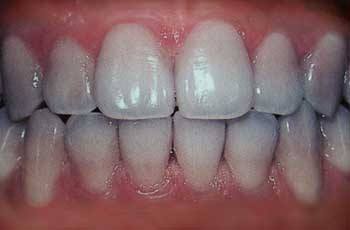
The products of degradation of proteins that were in the pulp tissue are than merged in the dentine tubules and color the teeth gray. Besides mentioned, bleeding from the pulp during endodontic treatment can cause gray teeth.
The blood that soaks hard dental tissue during endodontic treatment enters the dentinal tubules. In them, blood is being degraded which releases the iron. The iron than, in the presence of hydrogen sulfide, which is produced by bacteria, is converted into iron sulfide, which causes gray teeth.
Silver staining of teeth may appear on the teeth with amalgam fillings due to the migration of tin oxide or silver from amalgam and their deposition in dentinal tubules.
Hereditary abnormalities in creation of the dentin as dentinogenesis imperfecta can also be the cause of the gray discoloration of the teeth. In this case, staining of teeth is only one of the symptoms of the disorder that manifests itself in other organ systems also.
[divider style=’centered’]Blue and Green Teeth
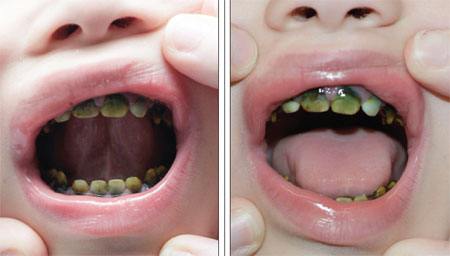 The children who had neonatal jaundice can develop a bluish color of the teeth. In addition, the literature describes the case of 11-month-old boy with congenital cytomegalovirus infection and neonatal jaundice, which have sprung up green deciduous teeth with hypoplastic enamel.
The children who had neonatal jaundice can develop a bluish color of the teeth. In addition, the literature describes the case of 11-month-old boy with congenital cytomegalovirus infection and neonatal jaundice, which have sprung up green deciduous teeth with hypoplastic enamel.
Although green teeth are quite a rare finding, they can be found in children with neonatal hyperbilirubinemia, in children with the inherent reduced saliency of biliary tract and children with fetal erythroblastosis.
[divider style=’centered’]The Brown Teeth
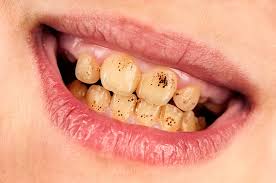 Brown color of the teeth may be the result of internal and external diseases. In the case of internal diseases, brown is more or less uniform with respect to the tooth surface which engages and affects a larger number of teeth, but not necessarily all teeth.
Brown color of the teeth may be the result of internal and external diseases. In the case of internal diseases, brown is more or less uniform with respect to the tooth surface which engages and affects a larger number of teeth, but not necessarily all teeth.
Brownish color of teeth may indicate dental fluorosis or the use of antibiotics which are tetracycline-based during pregnancy and periods of tooth development.
Brown teeth that resembles color of white coffee can be found in patients with hereditary problems of creating dentin: dentinogenesis imperfecta.
Brown staining of teeth may be the result of sinter chromogenic bacteria, which can be found on all the teeth on which they form small dark islands. As colonies of these bacteria develop more, they cover the greater surface of the tooth.
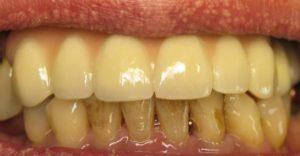 They first appear at the point where the gums and teeth meet in the form of a thin brown line that follows the contours of the gums. With further development they may completely cover the tooth crown. Although they can be removed in the dental office, their removal may require more visits to the dentist.
They first appear at the point where the gums and teeth meet in the form of a thin brown line that follows the contours of the gums. With further development they may completely cover the tooth crown. Although they can be removed in the dental office, their removal may require more visits to the dentist.
What is not to be regarded as staining of teeth or even just aesthetic deficiency, but the reason for the prompt visit to the dentist is brown teeth as a result of caries. The color of dental caries can vary from little black dots on the tooth surface to major affected brown colored surfaces or dark brown in color, indicating the advanced caries lesions. Dental caries is the most common on the biting surfaces of the teeth, but can also occur in other parts of the tooth.
[divider style=’centered’]Black Teeth
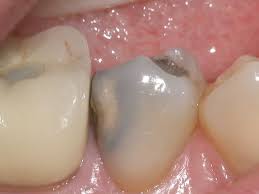 At the edges of the old and / or poorly crafted amalgam fillings can be found areas of discolored teeth. The dark, almost black color of those areas whose size can vary, suggests either the deposition of tin from amalgam fillings in hard tooth structure or the secondary caries, or both.
At the edges of the old and / or poorly crafted amalgam fillings can be found areas of discolored teeth. The dark, almost black color of those areas whose size can vary, suggests either the deposition of tin from amalgam fillings in hard tooth structure or the secondary caries, or both.
In addition, as previously mentioned, black can suggest the changes of the color of teeth caused by dental fluorosis.
[divider style=’centered’]Red Teeth
 With congenital Hepatic porphyrias – hereditary anomaly, which among other properties is characterized by circulation of hepatic porphyrias in the blood can, cause red-brownish staining of teeth. The hematoporphyrin is installed in the hard dental tissues after being shone by ultraviolet fluoresce red light. Such color change is noticed in the primary and the permanent teeth.
With congenital Hepatic porphyrias – hereditary anomaly, which among other properties is characterized by circulation of hepatic porphyrias in the blood can, cause red-brownish staining of teeth. The hematoporphyrin is installed in the hard dental tissues after being shone by ultraviolet fluoresce red light. Such color change is noticed in the primary and the permanent teeth.
Pink Teeth
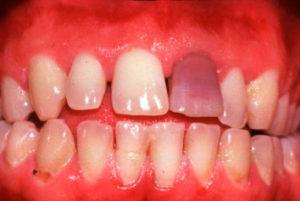 Teeth that assumed a pink color can be usually found in the drowned people and in some cases when non-natural and sudden death occurs (e.g., by hanging, drug intoxication and poisoning of the carbon monoxide).
Teeth that assumed a pink color can be usually found in the drowned people and in some cases when non-natural and sudden death occurs (e.g., by hanging, drug intoxication and poisoning of the carbon monoxide).
Pink teeth can also be found with the living people. In this case, the individual teeth changed the color due to resorption of the root canal.
The causes of resorption can be teeth trauma, orthodontic treatment, excessive teeth whitening and certain oral surgical procedures. Absorption is usually painless or with mild symptoms of pulp pain. At a time when internal resorption affects hard dental tissues in the dental crown and when it has so much progressed to thin the layer of dentin, pulp begins to sift, and a tooth takes on a pink color.
Conclusion
Although our teeth are usually white in color, its hue may vary significantly and substantially affect the aesthetic effect created by our smile.
Teeth can change color throughout life and because of dental erosion and abrasion, long-term and excessive consumption of food and beverages that can stain your teeth.
That can happen also because of certain bad habits such as smoking, improper and irregular oral hygiene, certain dental procedures and the like.
In addition, we can be born with teeth whose color is not ideal. The causes for this may be different, from taking tetracycline antibiotics during pregnancy, the disorder in the creation of dental tissues, discrepancies Rh factors of mother and child to the excessive intake of fluoride.
Although the causes of teeth staining or discoloration of the teeth may be different, with the application of modern dental methods, it is generally possible to repair and improve the aesthetics of our teeth and smiles.
